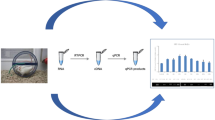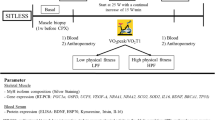Abstract
Exercise is known to upregulate mRNA synthesis for carnitine palmitoyl transferase1 (CPT1) and possibly also other mitochondrial carnitine acyltransferases in muscle tissue. The aim of this study was to test whether such an adaptation of oxidative metabolism in skeletal muscle is a systemic process and consequently, also affects other cells. Messenger RNA levels of five genes [carnitine palmitoyl transferases 1 and 2 (CPT1 and CPT2), carnitine acetyltransferase (CRAT), carnitine palmitoyltransferase 2 (CPT2), microsomal carnitine palmitoyltransferase (GRP58) and organic cation transporter (OCTN2)] were determined with quantitative real time polymerase chain reaction (PCR) in blood cells and in muscle biopsy samples from six cross country skiers before and 6 months after a high volume/low intensity exercise training, when training had elicited a significantly slower rate of lactate accumulation. Quantitative real time PCR showed that levels of mRNA in blood cells correlated significantly (CPT1B: P< 0.001) with those in muscle tissue from the same donors. After 6-months training, there was a 15-fold upregulation of CPT1B mRNA, a six to ninefold increase of CRAT mRNA, of CPT2 mRNA, GRP58 mRNA, and of OCTN2 mRNA. The observation of a concordant stimulation of CPT1, CPT2, CRAT, GRP58 and OCTN2 transcription in blood cells and muscle tissue after 6-month-endurance training leads the hypothesis of a common stimulation mechanism other than direct mechanical stress or local chemical environment, but rather humoral factors.


Similar content being viewed by others
References
Bergman BC, Wolfel EE, Butterfield GE, Lopaschuk GD, Casazza GA, Horning MA, Brooks GA (1999) Active muscle and whole body lactate kinetics after endurance training in men. J Appl Physiol 87:1684–1696
Bergman BC, Butterfield GE, Wolfel EE, Casazza GA, Brooks GA (1999) An evaluation of exercise and training on muscle lipid metabolism. Am J Physiol 276 (Endocrinol Metab 39):E106–E117
Bergstrom J. (1975) Percutaneous needle biopsy of skeletal muscle in physiological and clinical research. Scand J Clin Lab Invest 35:609–616
Bigard AX, Brunet A, Guezennec CY, Monod H (1991) Skeletal muscle changes after endurance training at high altitude. J Appl Physiol 71:2114–2121
Bonen A, Miskovic D, Kiens B. (1999) Fatty acid transporters (FABPpm, FAT, FATP) in human muscle. Can J Appl Physiol 24:515–523
Brown HR, Ni H, Benavides G, Yoon L, Hyder K, Giridhar J, Gardner G, Tyler RD, Morgan KT (2002) Correlation of simultaneous differential gene expression in the blood and heart with known mechanisms of adriamycin-induced cardiomyopathy in the rat. Toxicol Pathol 30:452–469
Campbell SF, Febbraio MA (2001) Effect of ovarian hormones on mitochondrial enzyme activity on the fat oxidation pathway of skeletal muscle. Am J Physiol Endocrinol Metab 281:E803–E808
Chiu KM, Schmidt MJ, Shug AL, Binkley N, Gravenstein S (1997) Effect of dehydroepiandrosterone sulfate on carnitine acetyl transferase activity and L-carnitine levels in oophorectomized rats . Biochim Biophys Acta 1344(3):201–209
Chiu KM, Schmidt MJ, Havighurst TC, Shug AL, Dayes RA, Keller ET, Gravenstein S (1999) Correlation of serum L-carnitine and dehydro-epiandrosterone sulphate levels with age and sex in healthy adults. Age Ageing 28:211–216
Graf T (2002) Differentiation plasticity of hematopoietic cells. Blood 99:3089–3101
Guzman M, Saborido A, Castro J, Molano F, Megias A. (1991) Treatment with anabolic steroids increases the activity of the mitochondrial outer carnitine palmitoyltransferase in rat liver and fast-twitch muscle. Biochem Pharmacol 141:833–835
Hawley JA (2002) Effect of increased fat availability on metabolism and exercise capacity. Med Sci Sports Exerc 34:1485–1491
Jeukendrup AE (2002) Regulation of fat metabolism in skeletal muscle. Ann N Y Acad Sci 967:217–235
Karlic H, Louda N, Pfeilstocker M, Keil F, Lohninger A, Pittermann E, Paukovits J (2001) Effect of the hemoregulatory peptide (pEEDCK)2 (pyroGlu-Glu-Asp-Cys-Lys)2 and MIP-1alpha is reduced in bone marrow cultures from patients with chronic myeloid leukemia (CML). Stem Cells19:321–328
Karlic H, Lohninger S, Koeck T, Lohninger A (2002) Dietary L-carnitine stimulates carnitine acyltransferases in the liver of old rats. J Histochem Cytochem 50(2):205–212
Kennedy SL, Stanley WC, Panchal AR, Mazzeo RS (2001) Alterations in enzymes involved in fat metabolism after acute and chronic altitude exposure. J Appl Physiol 90:17–22
Lapsys NM, Kriketos AD, Lim-Fraser M, Poynten AM, Lowy A, Furler SM, Chisholm DJ, Cooney GJ (2000) Expression of genes involved in lipid metabolism correlate with peroxisome proliferator-activated receptor gamma expression in human skeletal muscle. J Clin Endocrinol Metab 85:4293–4297
Lemischka I (2001) Stem cell dogmas in the genomics era. Rev Clin Exp Hematol 5:15–25
Lohninger A, Preis P, Linhart L, Sommoggy SV, Landau M, Kaiser E (1990) Determination of plasma free fatty acids, free cholesterol, cholesteryl esters and triacylglycerols directly from total lipid extract by capillary gas chromatography. Anal Biochem 186:243–250
McGarry JD, Brown NF (1997) The mitochondrial carnitine palmitoyltransferase system. From concept to molecular analysis. Eur J Biochem 244:1–14
Phillips SM, Green HJ, Tarnopolsky MA, Heigenhauser GF, Hill RE, Grant SM (1996) Effects of training duration on substrate turnover and oxidation during exercise. J Appl Physiol 81(5):2182–2191
Pilegaard H, Ordway GA, Saltin B, Neufer PD (2000) Transcriptional regulation of gene expression in human skeletal muscle during recovery from exercise. Am J Physiol Endocrinol Metab 279:E806–E814
Schrauwen P, Dorien PC, van Aggel-Leijssen GH, Wagenmakers AJM, Vidal H, Saris WHM, van Baak MA (2002) The effect of a 3-month low-intensity endurance training program on fat oxidation and acetyl-CoA carboxylase-2 expression. Diabetes 51:2220–2226
Sidossis LS, Wolfe RR, Coggan AR (1998) Regulation of fatty acid oxidation in untrained vs. trained men during exercise. Am J Physiol 274: E510–E515
Spina RJ, Chi MM, Hopkins MG, Nemeth PM, Lowry OH, Holloszy JO (1996) Mitochondrial enzymes increase in muscle in response to 7–10 days of cycle exercise. J Appl Physiol 80:2250–2254
Tamai I, China K, Sai Y, Kobayshi D, Nezu J, Kawahara E, Tsuji A (2001) Na+ -coupled transport of L-carnitine via high affinity carnitine transporter OCTN2 and its subcellular localization in kidney. Biochimica et Biophysica Acta 1512:273–284
Tikkanen HO, Hamalainen E, Harkonen M (1999) Significance of skeletal muscle properties on fitness, long-term physical training and serum lipids. Atherosclerosis 142:367–378
Tunstall RJ, Mehan KA, Wadley GD, Collier GR, Bonen A, Hargreaves M, Cameron-Smith D (2002) Exercise training increases lipid metabolism gene expression in human skeletal muscle. Am J Physiol Endocrinol Metab 283(1):E66–E72
Uenaka R, Kuwajima M, Ono A, Matsuzawa Y, Hayakawa J, Inohara N, Kagawa Y, Ohta S (1996) Increased expression of carnitine palmitoyltransferase I gene is repressed by administering L-carnitine in the hearts of carnitine-deficient juvenile visceral steatosis mice. J Biochem 119:533–540
Weghofer M, Karlic H, Haslberger A (2001) Quantitative analysis of immune mediated stimulation of tumor necrosis factor in macrophages at the mRNA-level and protein synthesis. Ann Hematol 80:733–736
Winder WW, Hardie DG. (1999) AMP-activated protein kinase, a metabolic master switch: possible roles in type 2 diabetes. Am J Physiol 277(1 Pt 1):E1–E10
Winder WW, Holmes BF (2000) Insulin stimulation of glucose uptake fails to decrease palmitate oxidation in muscle if AMPK is activated. J Appl Physiol 89:2430–2437
Acknowledgments
Sincere appreciation is extended to each of the athletes who participated in this study and to Dir. Heinrich Bergmüller of the ÖSV Olympic training centre in Obertauern /Salzburg. We wish to thank Lonza LTD for supporting the chemical analyses.
Author information
Authors and Affiliations
Corresponding author
Additional information
An erratum to this article can be found at http://dx.doi.org/10.1007/s00421-005-1405-5
Rights and permissions
About this article
Cite this article
Zeibig, J., Karlic, H., Lohninger, A. et al. Do blood cells mimic gene expression profile alterations known to occur in muscular adaptation to endurance training ?. Eur J Appl Physiol 95, 96–104 (2005). https://doi.org/10.1007/s00421-005-1334-3
Accepted:
Published:
Issue Date:
DOI: https://doi.org/10.1007/s00421-005-1334-3




